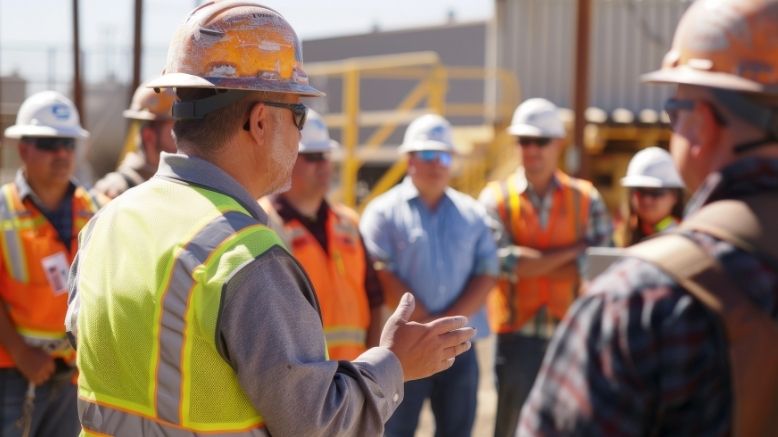— 9 min read
How Strong Construction Partnerships Build More Effective Projects


Last Updated Aug 13, 2024

D. Jesse Mase
Principle Operational Excellence Specialist
10 articles
D. Jesse Mase has a wealth of experience spanning architecture, construction, and real estate investment. His passion for the built environment led him to self-employment as a design builder, and later, managing large-scale commercial construction projects at Trehel Corporation. Currently, Jesse leverages his industry insights in his role as Principal Strategic Product Consultant at Procore, streamlining processes and solutions for construction project owners.

Kristen Frisa
Contributing Writer
111 articles
Kristen Frisa is a contributing writer for Procore. She also contributes to a variety of industry publications as a freelance writer focused on finance and construction technology. Kristen holds a Bachelor of Arts in Philosophy and History from Western University, with a post-graduate certificate in journalism from Sheridan College. She lives in Ontario, Canada.
Last Updated Aug 13, 2024

Construction projects are complex and rely on a number of important players to help them get off the ground. The architects and designers, owners, lenders and contractors on a project team all form unique partnerships as they work, relying on the expertise of the other to deliver a project.
Successful partnerships in construction are characterized by collaboration and integration. It's essential to involve all stakeholders, including trade partners, in the process to foster a more cohesive working environment. In the design-build bubble, there's much more space for the trade partner to also be a partner to both the contractor and architect.
This article will discuss the factors that impact the quality and health of construction partnerships, and how contractors can work toward healthier partnership bonds to improve the outcomes of their construction projects.
Table of contents
Understanding Construction Partnerships
Partnerships in the construction industry can be a broad subject. Generally, the owner usually sits as a leader of this partnership, and all other stakeholders are there because of the owner's presence. Each party has different roles and responsibilities on behalf of the owner. In very general terms, the owner kind of sits in the middle of this partnership, and we're all here because the owner's here. We all have different things that we do on the behalf of the owner.
Delivery Methods and Their Impact on Partnerships
The choice of project delivery method significantly influences construction relationships by dictating how partnerships are formed and managed.
Design-Bid-Build (DBB)
In the traditional design-bid-build delivery model, the owner starts by creating a partnership with an architect to design the project. Once the design is sufficiently developed, the owner hires a contractor to carry out the build. In a design-bid-build delivery motion, the owner hires designers and writes a contract that says “draw me a building to solve my problem.” Often, with a DBB, the architect will act similarly to an owner’s rep on the jobsite, also known as the construction administration, making sure the drawings are built to spec before payment applications are approved.
One major drawback of this method is the high likelihood of change orders due the possible disconnect between the architect and the contractor during the planning phase.

Design-Build (DB)
The design-build delivery model, on the other hand, begins the relationship with the contractor first, who then hires an architect to help complete the project. Design-build is rapidly gaining market share.
In this model, the contractor brings valuable field experience to the table, improving the design's buildability and cost-effectiveness. The contractor has a better chance of working with the architect to design something that can be built efficiently and plays a part earlier in the process. This delivery model often promotes a stronger partnership between the owners, contractor and the architect.
Challenges in Construction Partnerships
Working together on construction projects would test the strength of even the deepest relationships. Multiple parties work together on each project under significant time and money constraints. Then, toss in ego and professional reputations on the line – when any of these factors goes wrong, tempers may flair.
As any good therapist will confirm, good information gleaned through open lines of communication and clear mutually agreed-upon expectations can help even the most contentious partners understand one another better.
Unclear Owner Communication
An owner who is unclear about project goals or who is unwilling to be led through the design process by a quality design team can set a project up for failure before it ever begins. Design flaws and unending change orders create rifts between all project partners and can leave everybody chasing their tails.
Design and contracting teams need to be empathetic to owners, who carry a great deal of emotional and financial risk on construction projects, and need to be responsible to help them gain clarity and realistic expectations.
It helps to learn to practice active listening techniques during these critical conversations. Listen to subtext from others who may be trying to express something aside from what they’re actually saying. Repeat important information back to the speaker to ensure the correct meaning is understood.
Information Silos
Construction teams are increasingly accepting that effective partnerships cannot happen on construction projects if information silos exist – if each stakeholder is working off of information that is inaccessible or out of date from the others, they can’t work together toward a common goal.
Contractors are generally the stewards of contracts, schedules, and budgets, and need to make sure the owner or owner’s rep, architect, site staff and subcontractors are all working with current information. That often includes meeting minutes that the contractor has to share with the owner and design team.
Technology is helping construction teams to store information in organized and universally accessible cloud locations, to provide a single source of truth to anybody on the construction team at any time.
Competing Interests
Project stakeholders are all working toward some common goals on construction projects, but there are likely going to be some difficult situations over the course of the work that will cause parties to be in conflict with one another. When the original project plan doesn’t work out and there need to be changes to the construction contract, one of the parties will be responsible to cover the added costs that result. These competing interests can challenge even the most solid partnerships. However, these situations are more easily settled between people who have existing working relationships than between strangers.
Interpersonal Skill Gaps
The ability to deal with difficult situations is an important skill set on construction projects, the same way that estimating and budgeting are. While the industry expects excellence in a lot of areas, there isn’t the same call to treat each other excellently.
Project leaders have to define what it means for them to be team players and what skills they need to learn to get better at it. Construction professionals constantly work to learn and hone their skills within their crafts. Interpersonal skills are equally critical to work on and improve.
The strength of the project team can make or break its success. Contractors tend to deal with personnel based on resourcing — who has the skills to do the work, and is that person available to do it? But an equally important factor is whether or not the worker has the right disposition to work with the team.
Sharing Information
Working in construction leadership takes a certain level of self-assurance. Individuals on both design and construction sides of projects have a level of pride in their abilities — and sometimes a complete unwillingness to admit what they don’t know.
Sometimes that reaches so far that project teams will go ahead and do things the wrong way rather than asking for help, thus the importance of sharing information even when the other party doesn’t want to ask.
Construction technology circumvents this challenge by helping keep project data accessible for anyone to look up when they need the information so that they don’t need to reach out and ask. Giving all parties to the project means there are fewer chances that something will go in place incorrectly. Fewer mistakes and less rework helps projects, but it also helps partnerships.
Changing the information landscape means nobody has to change the personalities of the people on the project in order to get things right. It has a significant impact on project outcomes.
Stay updated on what’s happening in construction.
Subscribe to Blueprint, Procore’s free construction newsletter, to get content from industry experts delivered straight to your inbox.

Best Practices for Better Partnerships
Though, there is no way to ensure that construction partnerships thrive in any project, here are some strategies to foster strong, effective partnerships in the construction industry.
Build Trust
Building trust is fundamental to successful partnerships in construction. One way to think about this is through the concept of making "deposits" in the partnership bank account to build trust early in the project. Partnerships look like deposits and withdrawals, and you can't run them into the red. Mutual respect and understanding are key components of a healthy partnership.
Leverage Technology
Technology plays a transformative role in modern construction partnerships. Construction software platforms can significantly improve communication and reduce the risk of rework by providing accessible and up-to-date information. When the right information is available to everyone, it is less likely for there to be miscommunications that lead to the wrong work and all parties benefit from the decrease of rework.
Set and Manage the Right Expectations
Good partnerships can be broken by missed expectations. Proactive communication from all parties on expectations can keep partners on the right page and relationships intact — even through the inevitable bumps and hurdles of construction.
Proper Team Resourcing
Successful construction projects often hinge on appointing the right people with the appropriate skills and disposition for specific tasks. Effective team resourcing is essential for minimizing potential conflicts and ensuring project success. Your project team is make or break.
Establish Relationships Early
The success of projects in both the DBB and DB methods depends on open, collaborative and flexible partnerships, or they could fall prey to incompetency or self-gratification of any of the parties involved. The relationships often rise and fall to the level that’s established during the preconstruction phase. Most construction projects have unexpected elements. The relationships between parties will help decide how everyone handles those elements.
Collaboration between designers and contractors early on can help build pre-established relationships that can buffer them against the difficulties that arise during construction. For example, in a traditional DBB project, there is a window of time during bidding when the contractor can visit the site, submit questions about the drawings and get clarity to structure their bids appropriately. The design team will furnish them with an addendum to help provide more information.
If the construction team begins to dig and discovers bad soil, they can refer to the addendum they signed with the architect that tells them how to handle billing in the event they encounter bad soil. The work the teams did together during pre-construction helped avoid conflicts in this situation.
Better Partnerships for Better Projects
The importance of strong partnerships to the success of construction projects is tough to overstate. The quality of these partnerships between owners, designers, contractors and subcontractors impacts timelines, budgets and overall project quality.
Effective partnerships require clear roles, open communication, and mutual trust. Different delivery methods, such as design-bid-build and design-build, impact the ability for project stakeholders to develop and maintain relationships. Early collaboration and effective pre-construction planning are key to success.
Emotional intelligence and strong communication skills are essential for navigating interpersonal dynamics and resolving conflicts. Construction technology solutions further enhance partnerships by providing accessible, up-to-date information, reducing miscommunication and rework.
Project teams can create more collaborative and successful project environments by allowing teams the opportunities to work together, building teams that work well together, and using technology to break down information silos.
Was this article helpful?
Thank you for your submission.
100%
0%
You voted that this article was . Was this a mistake? If so, change your vote
Scroll less, learn more about construction.
Subscribe to The Blueprint, Procore’s construction newsletter, to get content from industry experts delivered straight to your inbox.
By clicking this button, you agree to our Privacy Notice and Terms of Service.
Thank you!
You’re signed up to receive The Blueprint newsletter from Procore. You can unsubscribe at any time.
Categories:
Written by

D. Jesse Mase
Principle Operational Excellence Specialist | Procore Technologies
10 articles
D. Jesse Mase has a wealth of experience spanning architecture, construction, and real estate investment. His passion for the built environment led him to self-employment as a design builder, and later, managing large-scale commercial construction projects at Trehel Corporation. Currently, Jesse leverages his industry insights in his role as Principal Strategic Product Consultant at Procore, streamlining processes and solutions for construction project owners.
View profile
Kristen Frisa
Contributing Writer | Procore
111 articles
Kristen Frisa is a contributing writer for Procore. She also contributes to a variety of industry publications as a freelance writer focused on finance and construction technology. Kristen holds a Bachelor of Arts in Philosophy and History from Western University, with a post-graduate certificate in journalism from Sheridan College. She lives in Ontario, Canada.
View profileExplore more helpful resources

Avoiding The App Trap: Overcome Financial Silos to Connect Field & Office
For general contractors working on razor-thin margins, rework and project delays are more than simple inefficiencies — they are major threats to the bottom line. For years, GCs have attempted...

Profit from Predictability: Construction Software as a Business Strategy
For general contractors, managing complex, multi-million-dollar projects, every project phase — from planning and budgeting to on-site execution — is an opportunity to lose time and money. Construction software is...

Defending Against Financial & Legal Risks on Megaprojects
The construction industry has seen marked growth in megaprojects. Some experts classify any project over $500 million as a megaproject, while others argue that the build needs to be $1...

Unlocking Project Intelligence: Moving from Raw Data to Actionable Insights
The construction industry faces a wide range of challenges, from ongoing labor shortages to frequent cost overruns. But some the biggest hurdles all stem from unpredictability. The general contractors (GCs)...
Free Tools
Calculators
Use our calculators to estimate the cost of construction materials for your next project.
Templates
Find a template to help you with your construction project tasks.
Material Price Tracker
Get the latest U.S. retail prices and view historical trends for common building materials.
Glossary
Explore key terms and phrases used in the industry.
